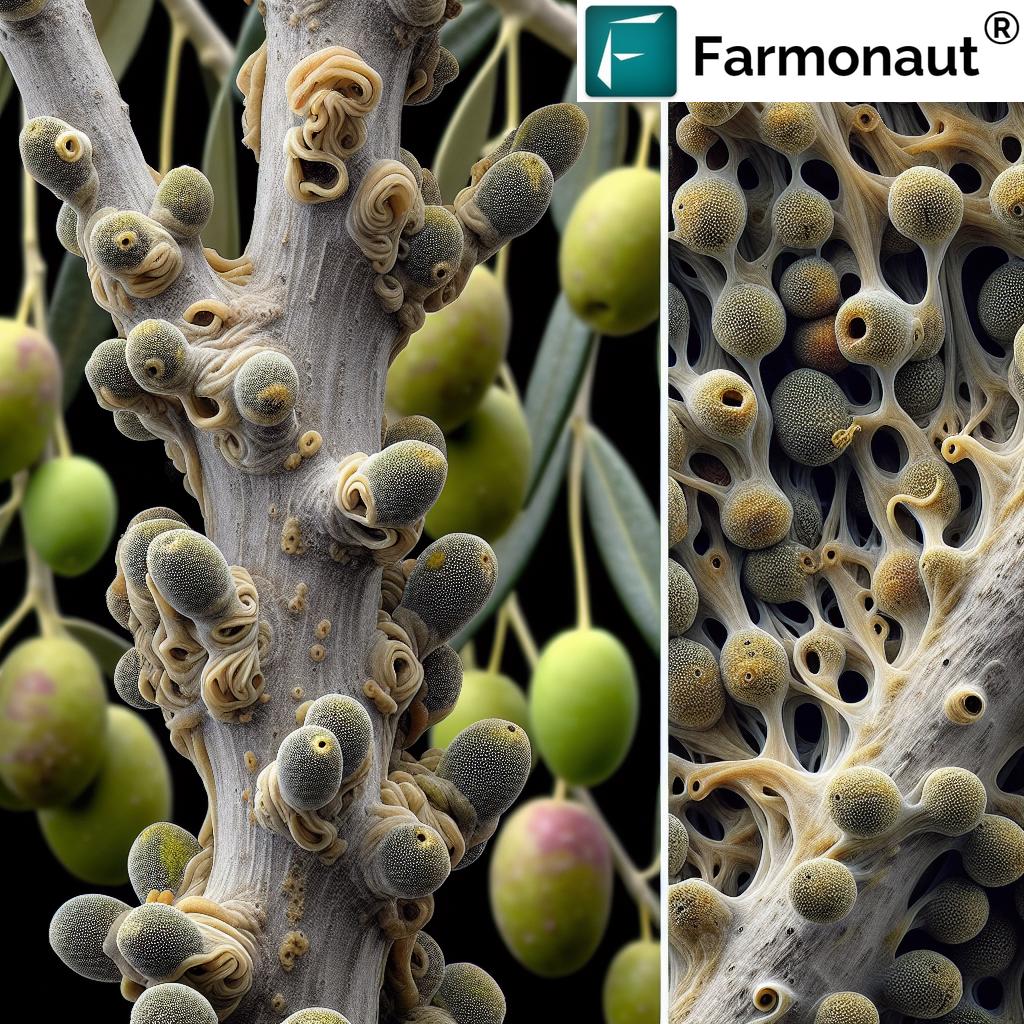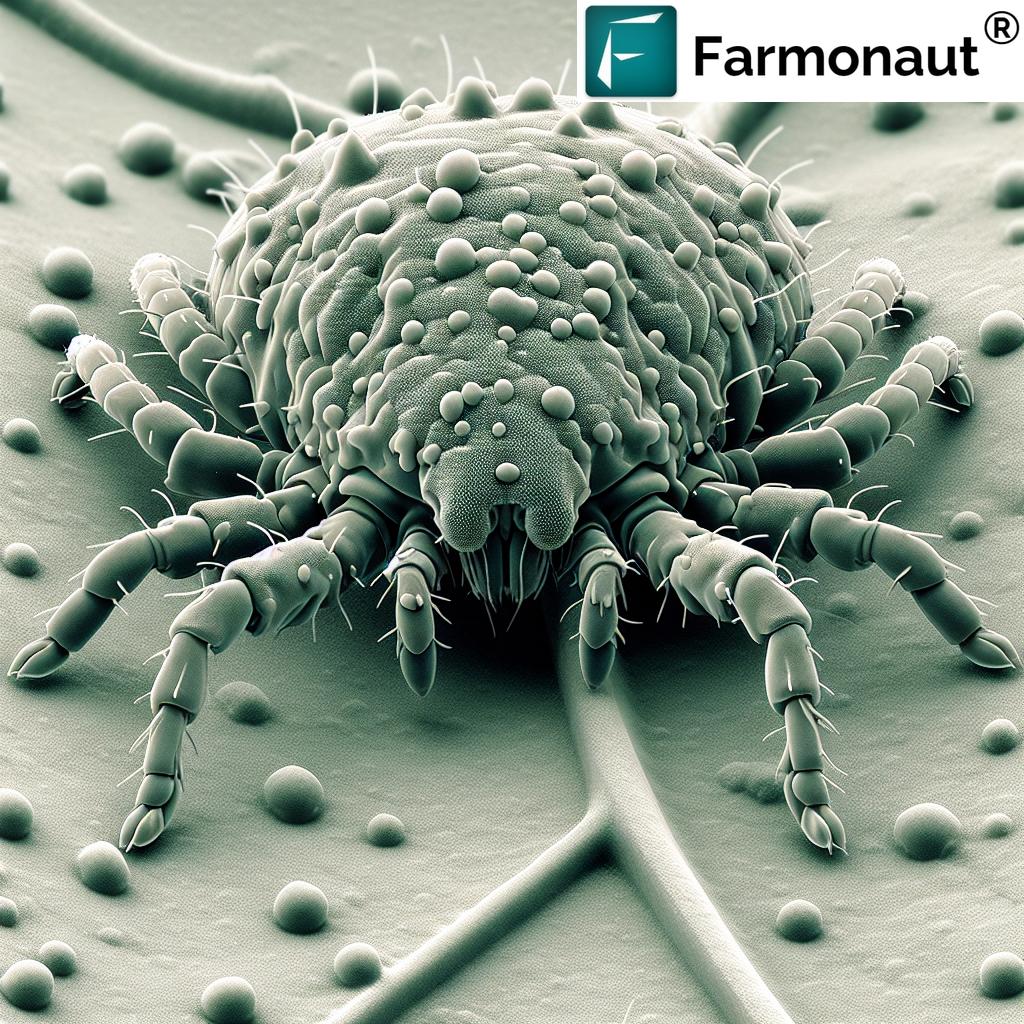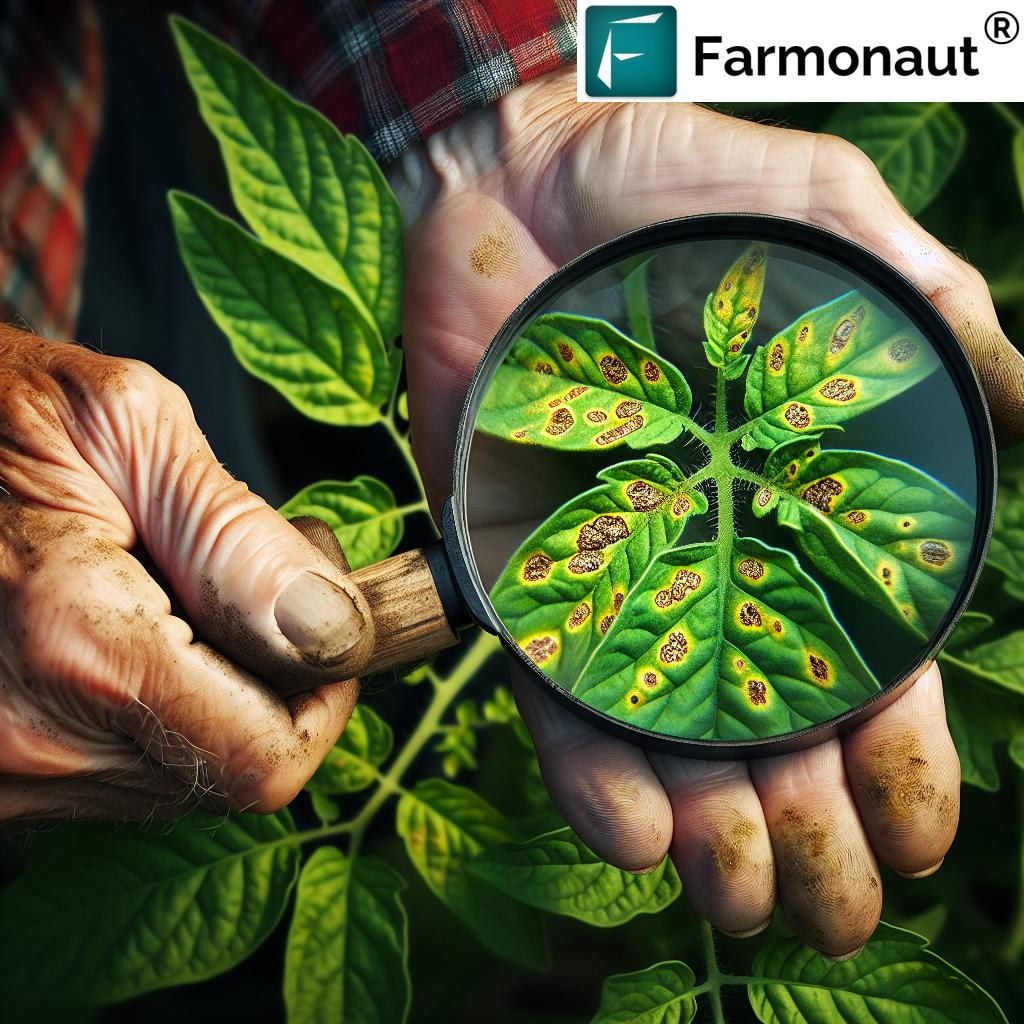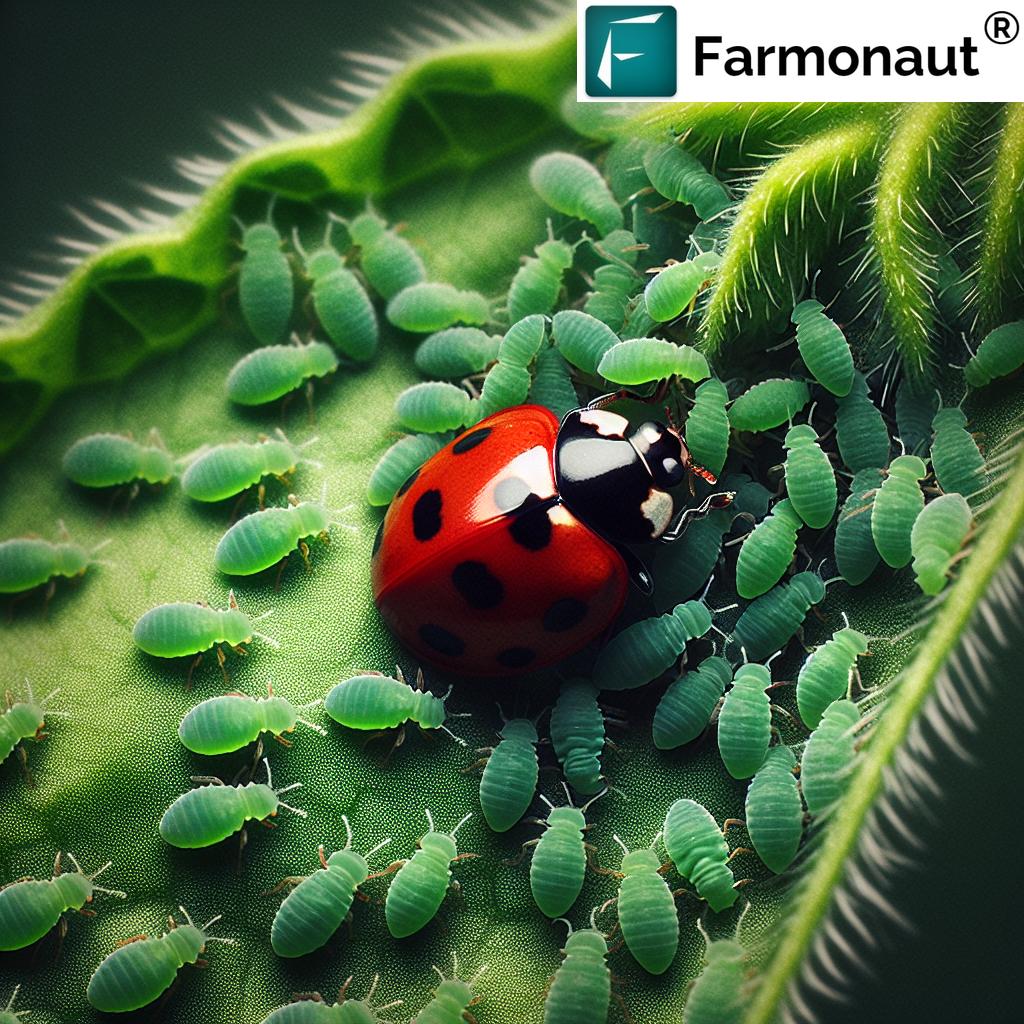Organic vs. Chemical Control: Managing Olive Knot Disease Caused by Pseudomonas savastanoi in Olive Trees

Olive knot disease, caused by the bacteria Pseudomonas savastanoi pv. savastanoi, is a significant challenge for olive growers worldwide. At Farmonaut, we understand the importance of effective disease management in maintaining healthy olive orchards and ensuring optimal yields. In this comprehensive guide, we’ll explore both conventional and organic methods for controlling this persistent bacterial infection, and how our advanced satellite monitoring technology can aid in early detection and intervention.
Understanding Olive Knot Disease
Olive knot disease, also known as olive tuberculosis, is a bacterial infection that primarily affects olive trees (Olea europaea). The causal agent, Pseudomonas savastanoi pv. savastanoi, belongs to the larger Pseudomonas syringae complex. This pathogen can cause significant damage to olive trees, leading to reduced yields and, in severe cases, tree death.
Symptoms and Progression
- Galls (Knots): The most characteristic symptom of olive knot disease is the formation of woody galls or knots on branches, trunks, and occasionally on leaves and fruit.
- Branch Dieback: Infected branches may wither and die, especially when galls encircle the entire branch.
- Defoliation: Severe infections can lead to leaf loss, particularly on heavily affected branches.
- Reduced Yield: The overall health and productivity of infected trees are compromised, resulting in decreased olive yield.

Disease Cycle and Transmission
Understanding the disease cycle is crucial for effective management. The bacteria primarily infect trees through wounds, which can be caused by various factors:
- Pruning cuts
- Frost damage
- Hail injury
- Harvesting wounds
- Leaf scars
Once the bacteria enter the tree, they multiply rapidly, causing the plant to produce excessive growth hormones. This leads to the formation of the characteristic galls. These galls serve as bacterial reservoirs, releasing more bacteria during wet conditions, which can then spread to other parts of the tree or neighboring trees.
Conventional Chemical Control Methods
Conventional chemical control methods have been widely used in managing olive knot disease. While effective, these approaches require careful consideration of environmental impacts and potential resistance development.
Copper-Based Treatments
Copper compounds are the most commonly used chemical control agents for olive knot disease. They work by creating a protective barrier on the tree’s surface and have bactericidal properties.
- Copper oxychloride: Applied as a spray, typically at 0.3-0.5% concentration.
- Copper hydroxide: Often used in alternation with copper oxychloride to reduce copper buildup in soil.
- Bordeaux mixture: A combination of copper sulfate and lime, effective but can cause phytotoxicity if not properly prepared.
Application Timing: Copper treatments are most effective when applied:
- Before autumn rains
- After winter pruning
- Before spring growth begins
- After hail storms or frost events
Systemic Antibiotics
While not widely used due to concerns about antibiotic resistance, some regions permit the use of systemic antibiotics for severe infections:
- Streptomycin: Can be effective but is restricted in many areas due to human health concerns.
- Kasugamycin: Less commonly used but may be an alternative where permitted.
Note: The use of antibiotics in agriculture is highly regulated and not permitted in many countries, especially for organic production.
Considerations for Chemical Control
- Resistance Management: Rotate between different chemical classes to prevent resistance development.
- Environmental Impact: Copper accumulation in soil can be harmful to beneficial soil microorganisms.
- Timing: Proper application timing is crucial for effectiveness.
- Coverage: Ensure thorough coverage of the tree, especially wound sites and areas prone to infection.
Organic Control Methods
At Farmonaut, we recognize the growing demand for organic olive production. Organic control methods focus on enhancing tree health, creating unfavorable conditions for the pathogen, and using naturally derived products to manage the disease.
Cultural Practices
- Pruning Hygiene:
- Disinfect pruning tools between cuts and trees
- Prune during dry weather to reduce infection risk
- Remove and destroy infected branches
- Water Management:
- Avoid overhead irrigation
- Improve soil drainage to reduce humidity around trees
- Resistant Varieties: Choose olive varieties with known resistance to olive knot disease when planting new orchards.
Biological Control Agents
Several biological control agents have shown promise in managing olive knot disease:
- Bacillus subtilis: This beneficial bacterium can colonize wounds and compete with P. savastanoi.
- Pseudomonas fluorescens: Some strains have shown antagonistic effects against the pathogen.
- Trichoderma spp.: These fungi can induce systemic resistance in olive trees.
Plant-Based and Natural Products
- Neem Oil: Has antimicrobial properties and can help protect pruning wounds.
- Propolis Extract: Derived from beehives, it has shown antibacterial activity against P. savastanoi.
- Compost Teas: Rich in beneficial microorganisms, they can enhance tree health and compete with pathogens.
Organic Copper Formulations
Some organic certification bodies allow the use of certain copper formulations:
- Copper octanoate
- Copper soap
- Low-dose Bordeaux mixture
Note: Even in organic production, copper use is often limited due to environmental concerns.
Integrated Management Approach
At Farmonaut, we advocate for an integrated approach that combines the best of both conventional and organic methods, tailored to each orchard’s specific needs and environmental conditions.
Key Components of Integrated Management
- Monitoring and Early Detection: Regular orchard inspections and use of advanced technologies like Farmonaut’s satellite monitoring can help detect early signs of infection.
- Cultural Practices: Implement proper pruning, irrigation, and sanitation practices.
- Biological Control: Incorporate beneficial microorganisms to enhance tree resistance and compete with pathogens.
- Targeted Chemical Use: When necessary, use chemical controls judiciously, focusing on critical infection periods.
- Resistant Varieties: Consider planting resistant varieties in new or replanted areas.
Farmonaut’s Role in Disease Management
Our satellite-based monitoring system can play a crucial role in managing olive knot disease:
- Early Detection: Our advanced imagery can detect subtle changes in tree health before visible symptoms appear.
- Precision Application: Identify specific areas requiring intervention, allowing for targeted treatment and reduced chemical use.
- Monitoring Effectiveness: Track the efficacy of control measures over time.
- Data-Driven Decisions: Use historical and real-time data to make informed management decisions.
To learn more about how Farmonaut can help you manage olive knot disease and other orchard health issues, visit our application page or explore our API services.
Comparison: Conventional vs. Organic Control Methods
| Method | Effectiveness | Cost | Environmental Impact |
|---|---|---|---|
| Conventional Chemical Control | High, rapid action | Moderate to High | Potential negative impact on soil and beneficial organisms |
| Organic Control | Moderate, slower action | Variable (can be higher initially) | Low, promotes ecosystem health |
| Farmonaut Satellite Monitoring | High for early detection | Cost-effective | No direct impact, supports precision management |
Farmonaut’s satellite monitoring can significantly enhance both conventional and organic approaches by enabling early detection and targeted interventions, ultimately reducing the need for extensive chemical applications and supporting more sustainable orchard management practices.
Case Studies: Successful Management of Olive Knot Disease
While we at Farmonaut do not provide specific case studies, we can share general insights from successful olive knot disease management strategies observed in various olive-growing regions:
Integrated Approach in Tuscany, Italy
Many olive growers in Tuscany have successfully managed olive knot disease through a combination of:
- Regular pruning and proper disposal of infected material
- Application of copper treatments before autumn rains and after winter pruning
- Use of biological control agents like Bacillus subtilis during the growing season
- Implementation of drip irrigation to reduce humidity around trees
Organic Management in California, USA
Organic olive growers in California have reported success with:
- Planting resistant varieties like ‘Sevillano’ and ‘Manzanillo’
- Applying compost teas and neem oil sprays
- Using pruning practices that promote air circulation within the canopy
- Implementing cover crops to improve soil health and tree resistance
Technology-Assisted Management in Spain
Large-scale olive producers in Spain have incorporated technology similar to Farmonaut’s satellite monitoring to:
- Detect early signs of stress in olive groves
- Target interventions to specific areas of the orchard
- Reduce overall chemical use by up to 30% through precision application
- Monitor the effectiveness of both chemical and biological control methods over time
Future Perspectives in Olive Knot Disease Management
As we look to the future, several promising developments are on the horizon for managing olive knot disease:
Advanced Biological Control
Research is ongoing to develop more effective and targeted biological control agents:
- Engineered bacteriophages specific to P. savastanoi
- Enhanced strains of beneficial bacteria with improved colonization abilities
- Plant growth-promoting rhizobacteria that induce systemic resistance in olive trees
Genetic Resistance
Breeding programs are focusing on developing olive varieties with enhanced resistance to olive knot disease:
- Identification of resistance genes in wild olive species
- Use of CRISPR-Cas9 technology to introduce resistance traits into commercial varieties
- Development of rootstocks that confer resistance to grafted scions
Nanotechnology
Emerging nanotechnology applications show promise for disease management:
- Nanoencapsulation of biological control agents for improved delivery and persistence
- Nano-formulations of copper that reduce environmental impact while maintaining efficacy
- Nanoparticles that enhance tree defense mechanisms
Advanced Monitoring and Prediction Models
At Farmonaut, we’re continuously improving our technology to provide even more valuable insights:
- Integration of hyperspectral imaging for earlier detection of plant stress
- Machine learning algorithms to predict disease outbreaks based on environmental conditions
- IoT sensors combined with satellite data for comprehensive orchard monitoring
Best Practices for Olive Knot Disease Prevention
Prevention is always better than cure. Here are some best practices that we at Farmonaut recommend for preventing olive knot disease:
1. Site Selection and Preparation
- Choose well-drained soils to reduce humidity around trees
- Ensure proper spacing between trees to promote air circulation
- Analyze soil and correct any nutrient deficiencies before planting
2. Variety Selection
- Plant varieties known to have some resistance to olive knot disease
- Consider using a mix of varieties to reduce disease spread
3. Cultural Practices
- Pruning:
- Prune during dry weather
- Disinfect tools between trees
- Avoid excessive pruning that can create numerous entry points for bacteria
- Irrigation:
- Use drip irrigation instead of overhead systems
- Avoid over-watering, which can increase humidity and disease risk
- Fertilization:
- Maintain balanced nutrition to promote tree health and resistance
- Avoid excessive nitrogen, which can increase susceptibility to infections
4. Monitoring and Early Intervention
- Regularly inspect trees for signs of galls or branch dieback
- Utilize Farmonaut’s satellite monitoring for early detection of tree stress
- Act quickly to remove and destroy any infected plant material
5. Protective Treatments
- Apply preventive treatments before periods of high risk (e.g., before autumn rains)
- Use copper sprays or organic alternatives as part of a regular protection program
- Apply wound protectants immediately after pruning or hail damage
6. Record Keeping and Analysis
- Maintain detailed records of disease occurrence, treatments, and outcomes
- Use Farmonaut’s data analysis tools to identify patterns and optimize management strategies
- Share data with local agricultural extension services to contribute to regional disease management efforts
Economic Impact of Olive Knot Disease
Understanding the economic impact of olive knot disease is crucial for growers to justify investment in prevention and control measures. While specific figures can vary widely depending on the region and severity of the outbreak, we can outline some general economic considerations:
Direct Yield Losses
- Severe infections can reduce olive yields by 10-20% or more
- Quality of olives and olive oil may be compromised, leading to lower market prices
- In extreme cases, entire trees may need to be removed and replaced
Increased Production Costs
- Additional labor for pruning and removing infected material
- Costs of chemical or biological control products
- Increased irrigation and fertilization to support tree health
Long-term Orchard Productivity
- Repeated infections can weaken trees, reducing their productive lifespan
- Replanting costs for severely affected areas
- Potential loss of organic certification if chemical interventions become necessary
Market Access
- Some markets may reject olives from infected orchards
- Reduced competitiveness in international markets due to quality concerns
Cost-Benefit of Prevention and Management
Investing in prevention and early detection, such as Farmonaut’s satellite monitoring services, can provide significant economic benefits:
- Early intervention can prevent widespread infection, saving on treatment costs
- Precision management reduces unnecessary chemical applications, lowering input costs
- Improved overall orchard health leads to better yields and quality
- Data-driven decision-making optimizes resource allocation and improves ROI
To explore how Farmonaut’s services can help you protect your olive orchard investment, visit our application page or download our mobile app for Android or iOS.
Regulatory Considerations for Olive Knot Disease Management
When managing olive knot disease, it’s crucial to be aware of and comply with relevant regulations. These can vary significantly between countries and even regions within countries. Here are some general regulatory considerations:
Pesticide Use
- Many countries have restrictions on the types of chemicals that can be used in olive production
- Maximum Residue Limits (MRLs) for chemical residues on olives and in olive oil must be adhered to
- Some regions require permits or licenses for certain chemical applications
Organic Certification
- Organic producers must follow specific guidelines for disease management
- Use of copper-based products is often limited in organic production
- Biological control agents must be approved for organic use
Quarantine and Movement Restrictions
- Some areas may have regulations to prevent the movement of potentially infected plant material
- Nurseries may be required to certify that olive plants are free from olive knot disease
Reporting Requirements
- In some regions, outbreaks of olive knot disease may need to be reported to agricultural authorities
- Failure to report or manage the disease could result in penalties
Water Use Regulations
- Irrigation practices may be subject to local water use regulations
- Runoff from chemical treatments may be regulated to protect water sources
It’s essential for olive growers to stay informed about local and national regulations regarding disease management. Farmonaut’s advisory services can help you navigate these regulatory landscapes while implementing effective disease management strategies.
Frequently Asked Questions (FAQ)
Here are some common questions we receive about olive knot disease management:
Q1: How can I tell if my olive trees have olive knot disease?
A: Look for characteristic woody galls or knots on branches and trunks. You may also notice branch dieback, leaf loss, and overall reduced tree vigor.
Q2: Can olive knot disease spread to other types of trees?
A: While Pseudomonas savastanoi pv. savastanoi primarily affects olive trees, similar bacteria can infect other plants in the Oleaceae family, such as ash and privet.
Q3: How often should I apply copper treatments to prevent olive knot disease?
A: The frequency depends on your local climate and disease pressure. Typically, applications are made before autumn rains, after winter pruning, and sometimes in spring. Always follow local guidelines and product labels.
Q4: Are there any completely resistant olive varieties?
A: While no olive variety is completely immune, some show higher resistance. ‘Frantoio’, ‘Coratina’, and ‘Empeltre’ are examples of varieties with some level of resistance.
Q5: How can Farmonaut’s satellite monitoring help with olive knot disease management?
A: Our satellite monitoring can detect early signs of tree stress, allowing for targeted interventions before visible symptoms appear. This can lead to more effective disease management and reduced chemical use.
Q6: Is it safe to consume olives from trees infected with olive knot disease?
A: While the bacteria itself is not harmful to humans, heavily infected trees may produce lower quality fruit. Always follow good agricultural practices and local food safety guidelines.
Q7: How long does it take for an infected tree to recover after treatment?
A: Recovery time varies depending on the severity of infection and the treatment method. It can take several months to a year for a tree to show significant improvement.
Q8: Can pruning alone control olive knot disease?
A: While proper pruning is crucial for disease management, it’s usually not sufficient on its own. An integrated approach combining cultural, biological, and (when necessary) chemical controls is most effective.
Q9: How does climate change affect the prevalence of olive knot disease?
A: Climate change may alter disease patterns. Milder winters and increased rainfall in some regions could favor disease development, while drought stress might increase tree susceptibility.
Q10: Can I use Farmonaut’s services if I have a small olive grove?
A: Absolutely! Our services are scalable and can be tailored to orchards of all sizes. Visit our application page to learn more about options for small-scale growers.
Conclusion
Managing olive knot disease requires a comprehensive, integrated approach that combines the best of conventional and organic methods. At Farmonaut, we’re committed to supporting olive growers with cutting-edge technology that enables early detection and precision management of orchard health issues.
By leveraging our satellite monitoring services, growers can stay ahead of potential outbreaks, optimize their management practices, and maintain healthy, productive olive orchards. Whether you’re managing a small family grove or overseeing large-scale olive production, our tools can be tailored to meet your specific needs.
We invite you to explore how Farmonaut can revolutionize your approach to olive knot disease management and overall orchard health. Visit our website to learn more about our services, or get started today by downloading our mobile app:
For developers interested in integrating our satellite and weather data into their own systems, check out our API documentation.
Together, we can work towards healthier olive orchards, improved yields, and more sustainable olive production practices. Join the Farmonaut community today and take the first step towards precision olive orchard management.










